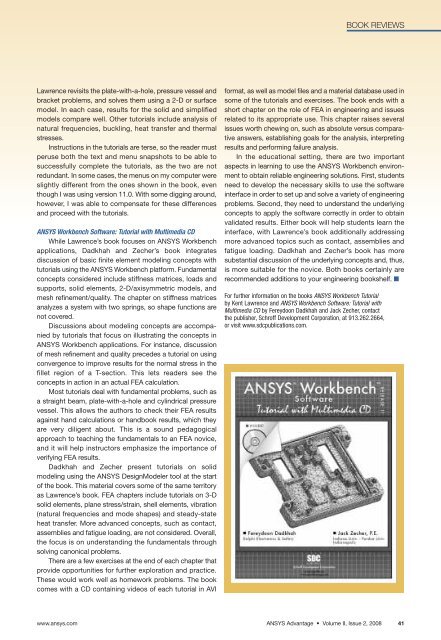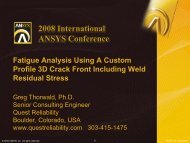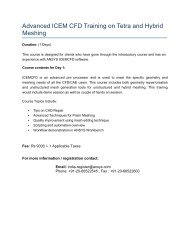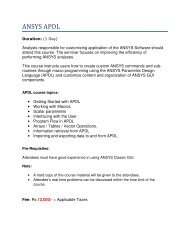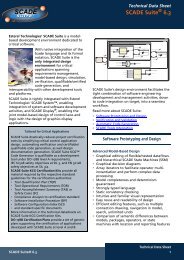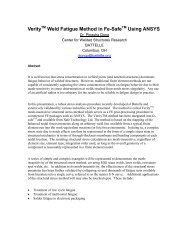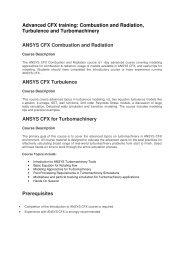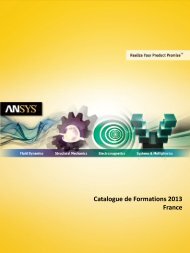Simulation - ANSYS
Simulation - ANSYS
Simulation - ANSYS
You also want an ePaper? Increase the reach of your titles
YUMPU automatically turns print PDFs into web optimized ePapers that Google loves.
Lawrence revisits the plate-with-a-hole, pressure vessel and<br />
bracket problems, and solves them using a 2-D or surface<br />
model. In each case, results for the solid and simplified<br />
models compare well. Other tutorials include analysis of<br />
natural frequencies, buckling, heat transfer and thermal<br />
stresses.<br />
Instructions in the tutorials are terse, so the reader must<br />
peruse both the text and menu snapshots to be able to<br />
successfully complete the tutorials, as the two are not<br />
redundant. In some cases, the menus on my computer were<br />
slightly different from the ones shown in the book, even<br />
though I was using version 11.0. With some digging around,<br />
however, I was able to compensate for these differences<br />
and proceed with the tutorials.<br />
<strong>ANSYS</strong> Workbench Software: Tutorial with Multimedia CD<br />
While Lawrence’s book focuses on <strong>ANSYS</strong> Workbench<br />
applications, Dadkhah and Zecher’s book integrates<br />
discussion of basic finite element modeling concepts with<br />
tutorials using the <strong>ANSYS</strong> Workbench platform. Fundamental<br />
concepts considered include stiffness matrices, loads and<br />
supports, solid elements, 2-D/axisymmetric models, and<br />
mesh refinement/quality. The chapter on stiffness matrices<br />
analyzes a system with two springs, so shape functions are<br />
not covered.<br />
Discussions about modeling concepts are accompanied<br />
by tutorials that focus on illustrating the concepts in<br />
<strong>ANSYS</strong> Workbench applications. For instance, discussion<br />
of mesh refinement and quality precedes a tutorial on using<br />
convergence to improve results for the normal stress in the<br />
fillet region of a T-section. This lets readers see the<br />
concepts in action in an actual FEA calculation.<br />
Most tutorials deal with fundamental problems, such as<br />
a straight beam, plate-with-a-hole and cylindrical pressure<br />
vessel. This allows the authors to check their FEA results<br />
against hand calculations or handbook results, which they<br />
are very diligent about. This is a sound pedagogical<br />
approach to teaching the fundamentals to an FEA novice,<br />
and it will help instructors emphasize the importance of<br />
verifying FEA results.<br />
Dadkhah and Zecher present tutorials on solid<br />
modeling using the <strong>ANSYS</strong> DesignModeler tool at the start<br />
of the book. This material covers some of the same territory<br />
as Lawrence’s book. FEA chapters include tutorials on 3-D<br />
solid elements, plane stress/strain, shell elements, vibration<br />
(natural frequencies and mode shapes) and steady-state<br />
heat transfer. More advanced concepts, such as contact,<br />
assemblies and fatigue loading, are not considered. Overall,<br />
the focus is on understanding the fundamentals through<br />
solving canonical problems.<br />
There are a few exercises at the end of each chapter that<br />
provide opportunities for further exploration and practice.<br />
These would work well as homework problems. The book<br />
comes with a CD containing videos of each tutorial in AVI<br />
BOOK REVIEWS<br />
format, as well as model files and a material database used in<br />
some of the tutorials and exercises. The book ends with a<br />
short chapter on the role of FEA in engineering and issues<br />
related to its appropriate use. This chapter raises several<br />
issues worth chewing on, such as absolute versus comparative<br />
answers, establishing goals for the analysis, interpreting<br />
results and performing failure analysis.<br />
In the educational setting, there are two important<br />
aspects in learning to use the <strong>ANSYS</strong> Workbench environment<br />
to obtain reliable engineering solutions. First, students<br />
need to develop the necessary skills to use the software<br />
interface in order to set up and solve a variety of engineering<br />
problems. Second, they need to understand the underlying<br />
concepts to apply the software correctly in order to obtain<br />
validated results. Either book will help students learn the<br />
interface, with Lawrence’s book additionally addressing<br />
more advanced topics such as contact, assemblies and<br />
fatigue loading. Dadkhah and Zecher’s book has more<br />
substantial discussion of the underlying concepts and, thus,<br />
is more suitable for the novice. Both books certainly are<br />
recommended additions to your engineering bookshelf. ■<br />
For further information on the books <strong>ANSYS</strong> Workbench Tutorial<br />
by Kent Lawrence and <strong>ANSYS</strong> Workbench Software: Tutorial with<br />
Multimedia CD by Fereydoon Dadkhah and Jack Zecher, contact<br />
the publisher, Schroff Development Corporation, at 913.262.2664,<br />
or visit www.sdcpublications.com.<br />
www.ansys.com <strong>ANSYS</strong> Advantage • Volume II, Issue 2, 2008 41


